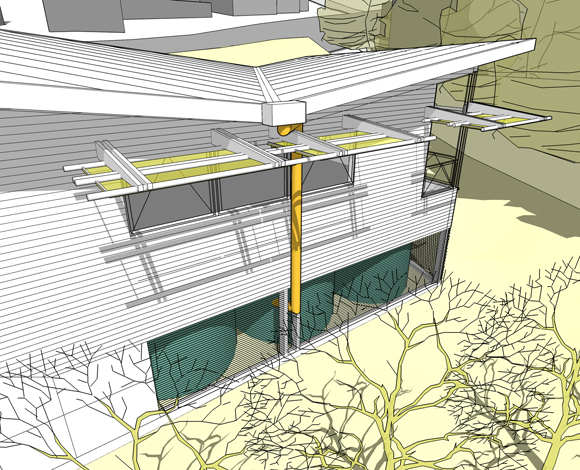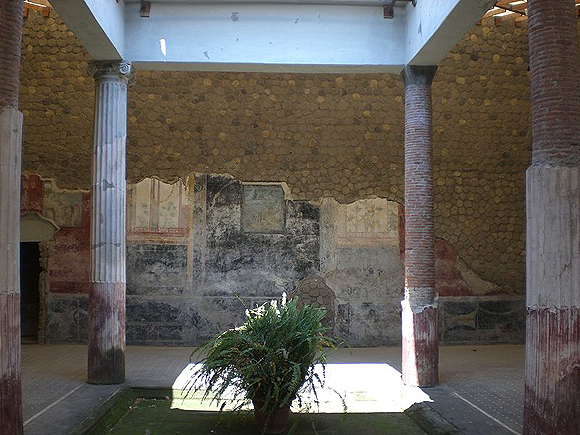
so much depends
upon
a red wheel
barrow
glazed with rain
water
beside the white
chickens
—William Carlos Williams
Rainwater catchment and greywater reuse are old ideas. As long ago as ancient Greece, Rome, and India, collection and storage of rainwater were important form-givers in buildings and cities. The roof of a Roman impluvium sloped toward a cistern in a central courtyard. This simple, elegant form not only created a daylit, central, public space, around which the building’s activities gathered; it also stored a precious resource, without which the building’s residents could not survive. The rain that fell on the roof was a harvest as important as the harvest in the fields. And, before the advent of modern plumbing, one can only imagine that in arid regions it was typical to use water more than once. After a sponge bath, it would be common sense to haul the tub out and pour it on the fruit trees . . .
Crisis:
Today, water falling on a building’s roof is treated very differently. From buildings and their surroundings, we typically route rainwater into underground storm drains. In many municipalities in California, storm drains and sanitary sewers share piping, treating rainwater as waste and creating problematic surges in sanitary sewers during storms.
Separate storm drains can be equally problematic. Surface runoff from streets, parking lots and other impervious surfaces is often full of contaminants, which storm drains distribute into local groundwater, lakes, rivers and tidal areas. Meanwhile, treated potable water, often conveyed hundreds of miles at enormous cost, is used once, to flush waste or to wash, and sent immediately to overburdened sewage treatment systems.
It’s not too difficult to see that our practices can and should change. A look at the predicted population growth in our state (30% by 2050), in light of our shrinking snow pack (predicted to decline by up to 40% in the same period), tells the tale in stark terms. While climate models differ on the likely duration and severity of future droughts, there is consensus that our snow pack will decrease and, with it, our reservoirs and municipal water supplies. This year’s decision by state and federal water officials to cut water deliveries to Central Valley farms is not a sustainable policy. Solutions to decrease demand are urgently needed.
More enlightened water use also brings several synergies. The California Energy Commission estimates that 20% of state electricity use and 30% of natural gas use are associated with the extraction, treatment, conveyance, use (including heating), and disposal of water. These enormous numbers make water conservation a critical strategy to reduce greenhouse gas emissions. In addition, the use of greywater for irrigation does more than cut the use of potable water. By diverting water from the sanitary sewer to the landscape, it draws on the natural filtration capacity of root and soil systems, decreasing the burden on aging infrastructure and helping to replenish groundwater, with associated benefits for local soil, plants and wildlife.
Policy Response
“In California, water is essential to our jobs, our schools, our families, our environment and our economy. With a drought, court-ordered water restrictions and an increasing population, the time for action is now.”—California Governor Arnold Schwarzenegger, April 21st, 2009.
With this statement, Governor Schwarzenegger introduced “Save Our Water,” a statewide program to educate Californians on the state’s water challenges and to encourage them to use less water.
It could be argued that the building industry has been a leader in addressing this emerging crisis. Through the USGBC and the instrument of LEED certification, architects have been encouraged for years to decrease water demand in their projects. LEED’s Water Efficiency (WE) category establishes standards for water use reduction in buildings and sites and for innovative wastewater technologies like greywater reuse. Pushing further, the Cascadia Chapter of the USGBC (which includes British Columbia) has developed the Living Building Challenge, an ambitious, prerequisite-based standard that requires 100% of a building’s water to come from captured precipitation or closed loop systems purified without chemicals. In addition, 100% of stormwater and building water discharge must be managed on site, without connection to municipal drains.
Municipalities, states, and professional organizations have sought to enable similar, if less ambitious goals. States such as Hawaii and Texas have long traditions of rainwater catchment in rural settings. In Hawaii, familiarity with these systems, paired with dwindling groundwater and geographic isolation, has led to state incentive programs for residential rainwater catchment. The Texas Commission on Environmental Quality publishes extensive, detailed guidelines for catchment systems. Many other states, including Virginia, Georgia, and Arizona, have rainwater catchment guidelines. California is not among these states but is moving in this direction.
In January 2009, the American Rainwater Catchment Systems Association (ARCSA), a professional advocacy organization, published its Rainwater Catchment Design and Installation Standards. Developed in collaboration with the American Society of Plumbing Engineers (ASPE), these standards propose uniform enforcement for rainwater catchment for potable and non-potable purposes in buildings and the landscape. They are intended to be consistent with and complementary to the Uniform Plumbing Code, International Plumbing Code, and relevant health regulations. The standards are undergoing peer review for inclusion in the next revision of the California Plumbing Code.
California greywater codes also show how policies have evolved. In 1992, the state took a leadership role by including greywater systems in Appendix G of the California Plumbing Code. But even after a 1997 update, this appendix has proven to be restrictive in practice, discouraging the installation of permitted greywater systems despite increased interest statewide. Now, after extensive lobbying from advocates and activists, the state is on the verge of approving a new greywater code that “is much more friendly to low tech, simple, safe systems, much more reasonable and easy to follow,” according to greywater educator and activist Laura Allen.
But neither the revisions to the California Plumbing Code nor the new greywater code has yet been adopted. With no relevant code to turn to (in the case of rainwater), or an unnecessarily restrictive code (in the case of greywater), building officials are understandably cautious. In this context, how can architects forge a timely response to the crisis? In the face of codes and enforcement that often lag behind stated policy goals, what is the most responsible approach? How do we build what the builder/activists of Oakland’s DIG Cooperative call “water smart”?
Practice
In my own practice, we have found ourselves following a contemporary variation of the impulse that led to the Roman impluvium. For a new home under construction in the Berkeley hills, the client’s interest in sustainable living dovetailed with our belief in water conservation. The resulting home is a simple shed, folded once to collect water at a single downspout in an open courtyard, configured to take advantage of a San Francisco Bay view. Water is routed to an 8,500-gallon cistern in the basement.
But, as the Living Building Challenge acknowledges, any project’s sustainability goals are “dependent on what is allowable by code.” While our governor has declared a drought emergency and urged rapid action, code enforcement is a conservative process. This is usually not for a lack of support from staff for a project’s goals. Landscape architect Josiah Cain, principal of Design Ecology in Mill Valley, notes, “These are smart people . . . . It’s more an issue of willingness to consider solutions and work through concerns relative to health and safety or institutional liability.”
Cain was speaking of greywater, but the same could be said of rainwater systems, particularly when interior use is proposed, even for non-potable purposes. In the case of our Berkeley hills project, we have been required to propose substituting our system for a method described in the code, when there is in fact no current code to which we can refer. Such conundrums abound.
Another typical situation is for two adjacent jurisdictions to have contradictory approaches. For example, while Berkeley two years ago approved the first constructed wetland-based residential greywater system in California, it has been unable to develop a consistently clear and appropriate response to rainwater catchment permitting, even when used only for irrigation. Meanwhile, across the bay, San Francisco’s groundbreaking municipal program to encourage residential rainwater catchment is paired with a refusal even to accept applications for greywater systems.
Yet, in the midst of what might seem an impossible regulatory context, new models are emerging. In the process, project applicants are learning about the intentions behind code enforcement, and building officials are exposed to the most advanced techniques and systems. Allen and several colleagues have spearheaded consensus building among Bay Area building officials around appropriate standards for greywater re-use. Meanwhile, Berkeley is exploring a pilot program for rainwater catchment systems, looking to the San Francisco program and ARCSA standards for guidance.
In spite of obstacles, water smart design is a timely idea of critical importance in California. But its regulatory terrain is not yet defined. While challenging and often frustrating, this situation presents architects with an opportunity to explore the seam where practice, education, and advocacy meet—a place we are going to have to spend more and more time as we seek to re-imagine a sustainable future for California.
Author Geoffrey Holton is principal of GHA, an architecture firm in Oakland. In addition to small residential and commercial work, the firm is currently pursuing community-based projects emphasizing sustainable urban futures.
Originally published 3rd quarter 2009, in arcCA 09.3, “Beyond LEED.”






